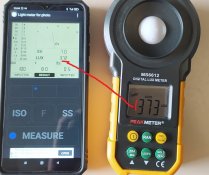Isn't there an issue with incident readings since a cell phone has no "globe"?
IMO it is not an issue because the front camera has a lens+pixels substituting the globe+sensor, and this substitution is fair.
Another thing is if the smartphone reading comes from the light sensor for the scren auto-brightness, in that case reading is very directional, and reading may change a lot when tilting the phone. Some Lux meter Apps use that sensor... I would not use much that kind of readfing. But we speak about incident reading from the front camera (screen side camera for selfies...), to me this one is fair.
The globe and the "front camera" readings are not exactly the same because the globe "integrates" the light rays received in all directions hitting the dome, while the front camera has a more limited angle of view.
Probably the light illuminating the subject from the side or at similar angle, (integrated by the globe but not by the front camera) is not of interest for the metering exposure anyway, because it will have a very small impact in the light power reaching the subject and reflected to the lens.
Anyway the globe is not a perfect light integration way, or at least it is not better or worse than integrating (say) a 60º angle on the incident light. Integrating the lateral illumination may make sense or not, but the principal information is how much light comes from the directions that will bounce to where the camera is.
Please check instructions for the R-27 Kodak Grey card, you will see that it is suggested that the card has to be oriented with a particular tilt-swing... this is a refinement compared to how the globe meters.
At all I'm saying that the globe is not a good way... What I'm saying is that the interaction between light direction, direction of the subject's faces, camera position, and the exposure we want... this is a complex matter, and while the globe is a good way to simplify the reading it is not perfect and it may not be the best. Instead measuring the light comming in a (say) 60º angle (centered in the camera-subject axis) may not be better or worse that the globe integration.
In practice... we have to check if the App+Phone we have works well for us...





